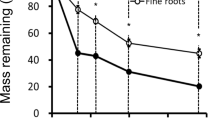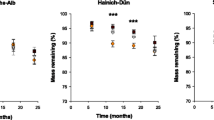Abstract
Mechanisms leading to high mean residence times of organic matter in subsoil horizons are poorly understood. In lower parts of the soil profile root material contributes greatly to soil organic matter (SOM). The objective of this study was to elucidate the decomposition dynamics of root-derived C and N in different soil depths during a 3 year field experiment and to examine the importance of different protection mechanisms as well as abiotic factors for the decomposition dynamics. Additionally, we assessed the effect of root litter addition on native SOM. Our conceptual approach included the exposure of litterbags with 13C and 15N labeled wheat root material mixed to loamy agricultural soil at three different soil depths (30, 60 and 90 cm). During the incubation period, we monitored soil temperature, humidity and the incorporation of root derived C and N into the soil microbial biomass and physical SOM fractions. Our results showed that abiotic decay conditions were better in subsurface horizons compared to the topsoil. Root litter addition significantly increased the size of microbial biomass in all three soil horizons. In the topsoil, root-derived C decomposition was significantly higher in the first 6 months of incubation compared to subsoil horizons. In 60 and 90 cm depths, a lag phase with development of soil microbial biomass seemed to be prevailing before decomposition was activated. For root-derived N, similar decomposition kinetics could be observed in top- and subsoil horizons. Despite of higher SOM contents, better soil structure and higher microbial activity in the topsoil horizon compared to subsoil horizons, the amounts of root-derived C and N remaining after 3 years were similar for all three depths. Most of the root-derived C and N was present as organo-mineral complexes or occluded in soil aggregates (oPOM), illustrating similar importance of these two protection mechanisms in all three soil depths. Addition of fresh root litter caused small losses of native soil C whereas native N was retained. We conclude that despite of similar SOM protection mechanisms, there are distinct differences in decomposition dynamics of root litter between top- and subsoil horizons. In the long run, the better abiotic decay conditions prevailing in subsoil horizons may compensate for their poorer physico-chemical characteristics.









Similar content being viewed by others
References
ven S, Recous S, Reyes V, Oliver R (2005) Mineralisation of C and N from root, stem and leaf residues in soil and role of their biochemical quality. Biol Fertil Soils 42:119–128
Batjes NH (1996) Total carbon and nitrogen in the soils of the world. Eur J Soil Sci 47:151–163
Berg B, McClaugherty C, Johansson MB (1993) Litter mass-loss in late stages of decomposition at some climatically and nutritionally different pine sites—long term decomposition in a scots pine forest. Can J Bot-Revue Canadienne De Botanique 71:680–692
Bird JA, Torn MS (2006) Fine roots vs. needles: a comparison of 13C and 15N dynamics in a ponderosa pine forest soil. Biogeochemistry 79:361–382
Bird JA, Kleber M, Torn MS (2008) 13C and 15N stabilization dynamics in soil organic matter fractions during needle and fine root decomposition. Org Geochem 39:465–477
Blume E, Bischoff M, Reichert JM, Moorman T, Konopka A, Turco RF (2002) Surface and subsurface microbial biomass, community structure and metabolic activity as a function of soil depth and season. Appl Soil Ecol 20:171–181
Chabbi A, Rumpel C (2004) Decomposition of plant tissue submerged in an extremely acid mining lake sediment: phenolic CuO-oxidation products and solid-state 13C NMR spectroscopy. Soil Biol Biochem 36:1161–1169
Eusterhues K, Rumpel C, Kleber M, Kögel-Knabner I (2003) Stabilisation of soil organic matter by interactions with minerals as revealed by mineral dissolution and oxidative degradation. Org Geochem 34:1591–1600
Eusterhues K, Rumpel C, Kogel-Knabner I (2005) Organo-mineral associations in sandy acid forest soils: importance of specific surface area, iron oxides and micropores. Eur J Soil Sci 56:753–763
Fontaine S, Barot S, Barré P, Bdioui N, Mary B, Rumpel C (2007) Stability of organic carbon in deep soil layers controlled by fresh carbon supply. Nature 450:277–281
Gale WJ, Cambardella CA (2000) Carbon dynamics of surface residue- and root-derived organic matter under simulated no-till. Soil Sci Soc Am J 64:190–195
Garcia-Pausas J, Casals P, Camarero L, Huguet C, Thompson R, Sebastià MT, Romanyà J (2008) Factors regulating carbon mineralization in the surface and subsurface soils of Pyrenean mountain grasslands. Soil Biol Biochem 40:2803–2810
Gill RA, Burke IC (2002) Influence of soil depth on the decomposition of Bouteloua gracilis roots in the shortgrass steppe. Plant Soil 241:233–242
Goberna M, Insam H, Klammer S, Pascual JA, Sanchez J (2005) Microbial Community structure at different depths in disturbed and undisturbed semiarid mediterranean forest soils. Microb Ecol 50:315–326
Guggenberger GA, Kaiser K (2001) Sorption of dissolved organic matter to soil particle surfaces: what happens with the carbon? Abstracts of Papers of the American Chemical Society 221, 50-GEOC
Hutchinson KJ, King KL, Nicol GR, Wilkinson DR (1990) Methods for evaluating the role of residues in the nutrient cycling economy of pastures. In: Harrison AF, Ineson P, Heal OW (Eds.), Nutrient Cycling in Terrestrial Ecosystems Field Methods. Application and Interpretation Elsevier Applied Science, Amsterdam, pp. 291–314
Jenkinson DS, Hart PBS, Rayner JH, Parry LC (1987) Modelling the turnover of organic matter in long-term experiments at Rothamsted. INTECOL Bull 15:1–8
John B, Yamashita T, Ludwig B, Flessa H (2005) Storage of organic carbon in aggregate and density fractions of silty soils under different types of land use. Geoderma 128:63–79
Kramer C, Gleixner G (2008) Soil organic matter in soil depth profiles: distinct carbon preferences of microbial groups during carbon transformation. Soil Biol Biochem 40:425–433
Lomander A, Kätterer T, Andrén O (1998) Modelling the effects of temperature and moisture on CO2 evolution from top- and subsoil using a multi-compartment approach. Soil Biol Biochem 30:2023–2030
Mikutta R, Kleber M, Torn MS, Jahn R (2006) Stabilization of soil organic matter: association with minerals or chemical recalcitrance? Biogeochemistry 77:25–56
Moni C, Rumpel C, Virto I, Chabbi A, Chenu C (2010) Relative importance of adsorption versus aggregation for organic matter storage in subsoil horizons of two contrasting soils. European Journal of Soil Science, accepted for publication
Parton WJ, Stewart JWB, Cole CV (1988) Dynamics of C, N, P and S in grassland soils—a model. Biogeochemistry 5:109–131
Paul EA, Follett RF, Leavitt SW, Halvorson A, Peterson GA, Lyon DJ (1997) Radiocarbon dating for determination of soil organic matter pool sizes and dynamics. Soil Sci Soc Am J 61:1058–1067
Paul KI, Polglase PJ, O’Connell AM, Carlyle JC, Smethurst PJ, Khanna PK (2003) Defining the relation between soil water content and net nitrogen mineralization. Eur J Soil Sci 54:39–47
Rasmussen C, Torn MS, Southard RJ (2005) Mineral assemblage and aggregates control carbon dynamics in a California conifer forest. Soil Sci Soc Am J 69:1711–1721
Rasse DP, Rumpel C, Dignac MF (2005) Is soil carbon mostly root carbon? Mechanisms for a specific stabilisation. Plant Soil 269:341–356
Rice C, Garcia F, Hampton C, Owensby C (1994) Soil microbial response in tallgrass prairie to elevated CO2. Plant Soil 165:67–74
Rovira P, Rovira R (2010) Fitting litter decomposition datasets to mathematical curves: towards a generalised exponential approach. Geoderma 155:329–343
Rovira P, Vallejo VR (1997) Organic carbon and nitrogen mineralization under Mediterranean climatic conditions: the effects of incubation depth. Soil Biol Biochem 29:1509–1520
Rovira P, Vallejo VR (2002) Mineralization of carbon and nitrogen from plant debris, as affected by debris size and depth of burial. Soil Biol Biochem 34:327–339
Rumpel C, Kögel-Knabner I (2010) Deep soil organic matter—a key but poorly understood component of terrestrial C cycle. Plant and Soil 1–16. doi:10.1007/s11104-010-0391-5
Rumpel C, Kögel-Knabner I, Bruhn F (2002) Vertical distribution, age, and chemical composition of organic carbon in two forest soils of different pedogenesis. Org Geochem 33:1131–1142
Salomé C, Nunan N, Pouteau V, Lerch TZ, Chenu C (2009) Carbon dynamics in topsoil and in subsoil may be controlled by different regulatory mechanisms. Glob Chang Biol 16:416–426
Schlesinger WH (1997) Biogeochemistry: an analysis of global change, 2nd edn. Academic, San Diego
Spielvogel S, Prietzel J, Kögel-Knabner I (2008) Soil organic matter stabilization in acidic forest soils is preferential and soil type-specific. Eur J Soil Sci 59:674–692
Trofymow JA, Moore TR, Titus B, Prescott C, Morrison I, Siltanen M, Smith S, Fyles J, Wein R, CamirT C, Duschene L, Kozak L, Kranabetter M, Visser S (2002) Rates of litter decomposition over 6 years in Canadian forests: influence of litter quality and climate. Can J For Res-Revue Canadienne De Recherche Forestiere 32:789–804
Vance ED, Brookes PC, Jenkinson DS (1987) An extraction method for measuring soil microbial biomass-C. Soil Biol Biochem 19:703–707
Virzo De Santo A, Berg B, Rutigliano FA, Alfani A, Fioretto A (1993) Factors regulating early-stage decomposition on needle litters in 5 different coniferous forests. Soil Biol Biochem 25:1423–1433
von Lützow M, Kögel-Knabner I, Ekschmitt K, Matzner E, Guggenberger G, Marschner B, Flessa H (2006) Stabilization of organic matter in temperate soils: mechanisms and their relevance under different soil conditions—a review. Eur J Soil Sci 57:426–445
von Lützow M, Kögel-Knabner I, Ekschmitt K, Flessa H, Guggenberger G, Matzner E, Marschner B (2007) SOM fractionation methods: relevance to functional pools and to stabilization mechanisms. Soil Biol Biochem 39:2183–2207
Xiang SR, Doyle A, Holden PA, Schimel JP (2008) Drying and rewetting effects on C and N mineralization and microbial activity in surface and subsurface California grassland soils. Soil Biol Biochem 40:2281–2289
Acknowledgment
We acknowledge Higher Education Commission (HEC) of Pakistan and the Région Poitou-Charentes: Excellence Environnementale et Développement des Eco-Industries for their financial support. Sylvie Recous is acknowledged for providing the labeled root material. We are highly indebted to the editor of this special issue and the reviewers for their helpful comments. We are also grateful to Xavier Charrier, Christophe de Berranger, Nicolas Pechot and Valérie Pouteau for their technical assistance.
Author information
Authors and Affiliations
Corresponding authors
Additional information
Responsible Editor: M. Francesca Cotrufo.
Rights and permissions
About this article
Cite this article
Sanaullah, M., Chabbi, A., Leifeld, J. et al. Decomposition and stabilization of root litter in top- and subsoil horizons: what is the difference?. Plant Soil 338, 127–141 (2011). https://doi.org/10.1007/s11104-010-0554-4
Received:
Accepted:
Published:
Issue Date:
DOI: https://doi.org/10.1007/s11104-010-0554-4




